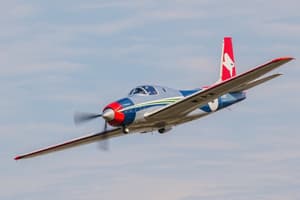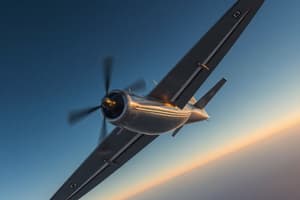Podcast
Questions and Answers
Which force counters gravity during straight-and-level flight?
Which force counters gravity during straight-and-level flight?
- Thrust
- Lift (correct)
- Drag
- None of the above
What happens to the potential energy of a glider as it glides downward?
What happens to the potential energy of a glider as it glides downward?
- It is converted into lift
- It is converted into thrust
- It is converted into drag
- It is converted into kinetic energy (correct)
Which type of drag increases with the square of speed?
Which type of drag increases with the square of speed?
- Induced drag
- Form drag (correct)
- Interference drag
- Skin friction drag
What is the force called that results from the difference in pressure between the front and back surfaces of an object?
What is the force called that results from the difference in pressure between the front and back surfaces of an object?
What is the type of drag caused by the roughness of the glider's surfaces?
What is the type of drag caused by the roughness of the glider's surfaces?
Which type of boundary layer generates more skin friction drag?
Which type of boundary layer generates more skin friction drag?
Which axis does yaw movement represent?
Which axis does yaw movement represent?
What controls the pitch of the glider?
What controls the pitch of the glider?
What does positive dynamic and static stability mean?
What does positive dynamic and static stability mean?
Which one of the following wing planforms is known for minimizing induced drag?
Which one of the following wing planforms is known for minimizing induced drag?
What is the purpose of a turbulator on a glider wing?
What is the purpose of a turbulator on a glider wing?
What causes interference drag on a glider?
What causes interference drag on a glider?
What is the consequence of a turbulent boundary layer on a glider wing?
What is the consequence of a turbulent boundary layer on a glider wing?
Which type of wing design is more efficient in terms of lift-to-drag ratio (LD), but has the drawback of potentially causing loss of control with little warning?
Which type of wing design is more efficient in terms of lift-to-drag ratio (LD), but has the drawback of potentially causing loss of control with little warning?
Which wing design creates more induced drag than an elliptical wing of comparable size?
Which wing design creates more induced drag than an elliptical wing of comparable size?
Which wing design is most frequently found on gliders and produces less drag than the rectangular wing, assuming equal wing area?
Which wing design is most frequently found on gliders and produces less drag than the rectangular wing, assuming equal wing area?
What is the primary consideration for choosing a tapered wing over a rectangular wing?
What is the primary consideration for choosing a tapered wing over a rectangular wing?
Which of the following is the correct definition of the glide polar graph?
Which of the following is the correct definition of the glide polar graph?
What is the minimum sink speed?
What is the minimum sink speed?
What is the best glide speed?
What is the best glide speed?
How does adding water ballast affect the glide polar graph?
How does adding water ballast affect the glide polar graph?
According to Newton’s Third Law of Motion, for every action there is an equal and opposite reaction. Thus, the air that is deflected downward also produces an upward 3-2 (lifting) reaction.
According to Newton’s Third Law of Motion, for every action there is an equal and opposite reaction. Thus, the air that is deflected downward also produces an upward 3-2 (lifting) reaction.
Which factor does not affect the amount of lift generated by an aircraft wing?
Which factor does not affect the amount of lift generated by an aircraft wing?
What happens to lift when airspeed is doubled, assuming all other factors remain the same?
What happens to lift when airspeed is doubled, assuming all other factors remain the same?
What is the relationship between the coefficient of lift and the angle of attack?
What is the relationship between the coefficient of lift and the angle of attack?
Flashcards are hidden until you start studying
Study Notes
Forces in Flight
- Lift counters gravity during straight-and-level flight.
- The force resulting from the difference in pressure between the front and back surfaces of an object is called lift.
Energy of Glider
- As a glider glides downward, its potential energy decreases.
Drag
- Parasite drag increases with the square of speed.
- The type of drag caused by the roughness of the glider's surfaces is skin friction drag.
- Turbulent boundary layer generates more skin friction drag.
- Interference drag is caused by the interaction between different parts of the glider.
Wing Design and Drag
- Elliptical wing planform is known for minimizing induced drag.
- A turbulator on a glider wing is used to create a turbulent boundary layer and reduce drag.
- A rectangular wing design creates more induced drag than an elliptical wing of comparable size.
- Tapered wing design is more efficient in terms of lift-to-drag ratio (LD) but has the drawback of potentially causing loss of control with little warning.
- The primary consideration for choosing a tapered wing over a rectangular wing is to reduce drag.
Glide Polar Graph
- The glide polar graph shows the relationship between the glider's speed and sink rate.
- The minimum sink speed is the point on the glide polar graph where the sink rate is minimum.
- The best glide speed is the point on the glide polar graph where the lift-to-drag ratio is maximum.
- Adding water ballast to the glider affects the glide polar graph by shifting the curve to the right.
Lift and Angle of Attack
- According to Newton's Third Law of Motion, the air that is deflected downward also produces an upward lifting reaction.
- The factor that does not affect the amount of lift generated by an aircraft wing is the weight of the aircraft.
- When airspeed is doubled, assuming all other factors remain the same, lift is quadrupled.
- The coefficient of lift increases with the angle of attack until stall occurs.
Studying That Suits You
Use AI to generate personalized quizzes and flashcards to suit your learning preferences.




